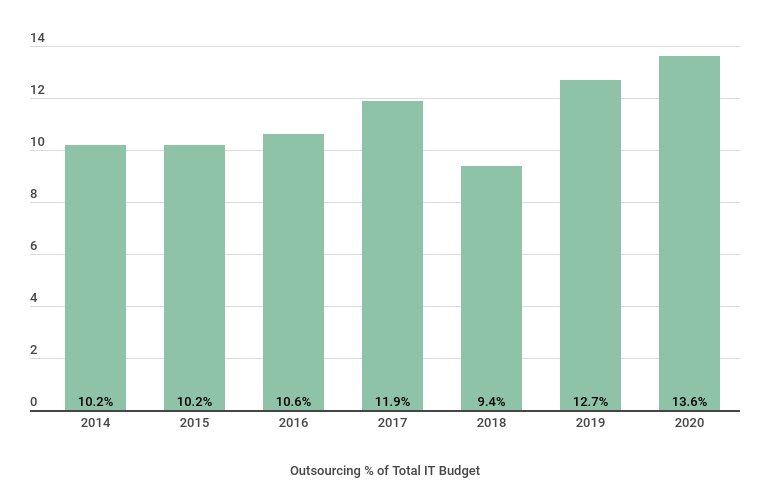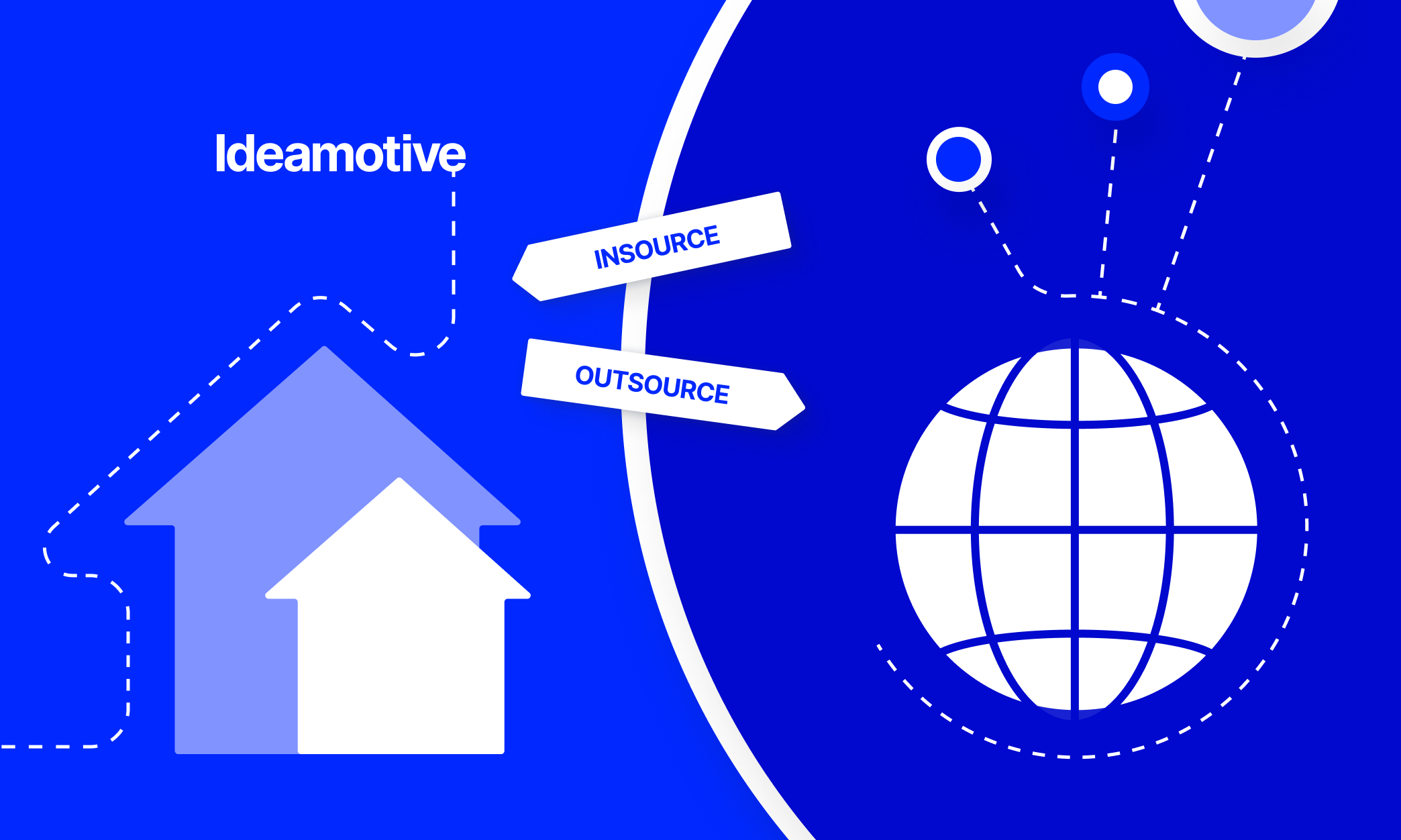When looking for IT professionals, companies are often faced with the choice between outsourcing and insourcing and choosing the most efficient method of spreading work. This strategic choice can greatly affect the cost, quality, and resource aspects of an organization. Thus, more and more companies are giving preference to traditional IT outsourcing models, rather than the search for specialists within the company. Increased company focus, access to exceptional capabilities, and cost reduction are some of the major factors driving the IT outsourcing market.
However, there is no "one size fits all" in the “IT outsourcing vs insourcing” picture. It is likely that most businesses will need to outsource at least some of the services that have a very specialized platform or support requirements. But how far you can go by relinquishing responsibility for hosting, managing, and supporting IT services is a very individual decision.
Therefore we offer you to dive a bit deeper into this topic. First, let’s see the exact definitions.
What are IT outsourcing and IT insourcing?
Core aspects of IT outsourcing vs insourcing
- Outsourcing is the process of hiring an outside organization that is not affiliated with the company to perform specific tasks.
- Insourcing, on the other hand, is a business practice carried out within an organization's operating infrastructure.
The main difference between outsourcing and insourcing lies in the methods in which work, projects or tasks are allocated to different companies and departments for strategic purposes.
Recent global stats
Insourcing is a good old method that was used by our grandads. Since that, having a thorough look at its stats seems a bit excessive. However, this can’t be said about outsourcing, which has been a popular trend since 1989. Over the past three decades, it has become an integral part of business management on a global scale.
That's why we think it's important to dive into the latest data and get all the most important outsourcing statistics for 2022.
#1. Before the pandemic, the global outsourcing market reached $92.5 billion
Global outsourcing revenue has been on an unstable trajectory since 2012. Revenue peaked at $104.6 billion in 2014 before dropping to $88.9 billion the following year. Outsourcing statistics show that the upward and downward trend in revenue continues, and due to COVID-19, these numbers have not yet stabilized.
#2. Every year, about 300,000 jobs are outsourced from the US
US outsourcing statistics like this one makes it easy to understand why so many people have a negative view of outsourcing. Negative sentiment is especially strong when there is a big economic crisis; we have just experienced the second-largest recession in history, and the full impact of the global pandemic is yet to be seen.
So it's no surprise that at the height of the Great Recession, 86% of Americans blamed outsourcing for aggravating the crisis.
#3. More than 44% of chief intelligence officers say they use outsourcing providers more now than just five years ago
The latest offshoring statistics show that the IT sector is moving the fastest towards outsourcing. In fact, about 64% of offshore technology functions outsourced are related to software development.
About 51% of technology executives say they hire remote developers for application development and software maintenance, and 40% outsource their data centers.
#4. Saving money is the top motivation for IT outsourcing
Freeing up resources to focus on core business is the most frequently cited reason for outsourcing IT functions (49%). Saving money is secondary, but still a top priority. About 45% of companies that outsource IT functions say their IT outsourcing projects are designed to save money. About 46% say outsourcing allows them to access skill sets that are not available internally.
#5. 71% of CFOs outsource or offshore some of their services
Financial companies are among those who most often use outsourcing. About 70% of retail and transport firms do the same, while job outsourcing statistics show that the top spot is still reserved for pharmaceutical companies, with approximately 82% of which outsource services.
#6. Despite or perhaps because of the COVID-19 pandemic, the outsourced share of IT in the budget continued to rise from 12.7% in 2019 to 13.6% in 2020
A yearly comparison of outsourcing statistics reveals a strange and growing gap between large and small companies outsourcing work.
IT security and data center operations saw the largest decline in outsourcing three years ago, down 6% year-over-year. The fall was mainly due to the fact that small and medium-sized businesses switched to cloud computing, which eliminated the need to outsource the maintenance of internal IT infrastructure.
A recent study found that the pandemic and the transition to a work-from-home model did not have a negative impact on global IT outsourcing. Conversely, outsourcing spending has risen to 13.6% of the average IT budget in 2020.
The global IT outsourcing market is expected to grow by $98 billion from 2020 to 2024, growing by 5% on average.

Given these numbers, hiring remote software devs is the best post-Covid strategy!
What is outsourcing in business?
Outsourcing uses the advanced workforce of an outside organization to perform tasks, as well as the resources of an outside organization for services and products. Saving money on costs is usually the motive for outsourcing work to another company. Industries such as telecommunications, travel, transportation, media, and retail often rely on outsourcing to complete important projects or tasks.
Companies can use outsourcing to better focus on the core aspects of the business. That is, outsourcing non-core activities can increase efficiency and productivity. At the same time, outsourcing can affect jobs ranging from customer support to manufacturing, as well as technology and the back office. (More about benefits below).
An organization's control over operations and decisions will differ between outsourcing and insourcing. Organizations that outsource a particular service or manufacturing process have minimal managerial control over the practices of the external organization that has been hired for the project. For example, an organization that is known for its friendly customer support does not have the ability to provide or manage how an external help center interacts with customers.
What is insourcing in business?
Insourcing assigns a project to a person or department within a company instead of hiring an outside person or company. It uses developed resources within the organization to accomplish tasks or achieve a goal. For example, an organization may attract technical support for a new product because the company already has technical support for another product within the organization.
In addition, insourcing typically hosts new operations and processes within the organization. For this reason, insourcing can be more expensive for a company because it often involves introducing new processes to run another division within the organization. (Again, see more about benefits and concerns in the next chapter).
IT outsourcing vs insourcing: benefits and concerns
Benefits of outsourcing IT services
Cost savings
Most often, the driving force behind the transition to managed services is cost. Removing an organization from expensive technical resources whose expertise may be needed only occasionally can bring significant economic benefits.
One of the often-overlooked benefits is that outsourcing eliminates the cost of employee turnover, vacations and sick days, and other downtimes that come with in-house resources.
Similarly, the sharing of complex technology platforms can provide significant cost savings for businesses. Infrastructure as a Service (IaaS), Software as a Service (SaaS), Telecommunications as a Service (TaaS), and other offerings can provide significant economies of scale. Paying for part of the service as a tenant is in most cases cheaper than the cost of equipment, licensing, security, maintenance, and other related costs for your own solution.
Availability of expertise
A multi-customer managed service provider will be able to receive and pay for a high level of knowledge about the products they offer.
The cost of hiring at this level can be prohibitive for a single business, especially when you consider that:
- The specialized knowledge of an expert may not be required very often.
- In most cases, this expert is likely to take on tasks well below their skill level, which are unlikely to be attractive or satisfactory.
For critical systems that need to be available around the clock, one resource will not be enough. A managed provider will have multiple resources and availability to meet consistent service requirements, regardless of when problems occur.
Investment considerations
The use of managed services allows an organization to translate what would be a capital expense (CapEx) into an operating expense (OpEx). This can make it easier to negotiate new services.
Try before you buy
Outsourcing services give you a “try before you buy” opportunity, ensuring that the service you are considering is fit for your purpose and will provide the value you are looking for.
This is not possible if you are building a solution in-house. In this case, you must be sure that you will reap the benefits of the investment from the very beginning. Once you have purchased and installed the infrastructure and software, it will be too late to change your mind.
Flexibility
An important advantage of hiring offshore developers is the ability to quickly add and remove capacity to meet changing requirements.
For example, a government tax authority may have requirements for additional capacity during annual reporting periods, but will not require it for the remaining 11 months of the year.
- The managed service provider can quickly provision this additional capacity and remove it when it is no longer needed.
- The internal solution must always have available power to meet the peak periods of the year, resulting in wasted and wasted power.
Flexibility can also be important when planning new services or changing old ones. Vendors will be able to quickly "deploy" virtual machines as test environments and just as quickly remove them. These temporary capacity increases are very valuable features that are uneconomical for most indoor environments.
Stick to what you're good at
A final consideration for outsourcing is if you work in a retail business, an accounting firm, or a hospital, then you have the skills to match those specialties. Does it really make sense to expand IT capabilities within the organization and for instance employ QA engineers? Wouldn't it be better to focus on your core business and leave IT to the experts in that area?
Risks of outsourcing IT services
Security questions
In a world where data breaches make headlines at an alarmingly constant rate, many organizations will naturally be concerned about entrusting their customer data and sensitive intellectual property to a third party. Larger providers can give you little control over where in the world your data is stored, and this can understandably be a concern.
Regardless of how many contractual guarantees you have provided, you still transfer custody of that information to another company over which you have no day-to-day control. While contracts may provide you with remedies if something goes wrong, this is unlikely to restore a reputation that has been damaged by a major data breach.
Loss of control
The idea of handing over control of a critical part of your business to a third party can be troubling. The service provider will be responsible for compliance and oversight of IT service management.
Handing over that control to a provider can be tricky and hectic, especially if you're using a provider you haven't worked with before. Assuage these concerns by meeting with other companies that use the provider you suggested.
Unplanned additional expenses
Outsourcing should save money. However, choosing the cheapest offer may not be the best option. You must understand exactly what is covered by your contract and what will be classified as additional services.
Make sure you understand exactly what your chosen service level entitles you to - are you sure it will meet your needs? If it doesn't, it will almost certainly cost you more than a higher level of contracted service.
Please, feel free to check out our IT outsourcing webinar for a better understanding of how to minimize top IT outsourcing challenges.
Benefits of insourcing IT services
Practical service
The on-site team can update and manage not only your software but also maintain the hardware on-site.
Communication
Since your insourcing team will be able to communicate with all departments of your business, they will understand business processes at a deeper level, which will lead to a more accurate identification of possible bottlenecks in the work.
Trained employees for your business needs
You can build your IT team from unique professionals, formed specifically for the needs of your company, which means that well-trained employees will be ready for non-standard projects and find solutions in their work faster.
Better workflow control
You can contact your insource team anytime you need them. In addition, it is much easier to evaluate the work and contribution of each employee to the project, as well as to motivate them, which leads to greater productivity and dedication.
Cons of IT insourcing
Higher costs
While insourcing aims to reduce costs by spreading the workload more evenly among employees, it can still be quite expensive as it includes the costs of sourcing, hiring, onboarding, training, salaries, and paying taxes.
Problems with headhunting
It can be difficult to find the right specialist for a job. Moreover, it can take time and money to improve the skills of employees.
The indispensability of some employees
If you have a unique project and valuable people decide to leave the company, this can lead to a stop or even closure of the project.
Key takeaways
Having looked at the main advantages of insourcing and outsourcing we are ready to come up with a bunch of takeaways:
- Outsourcing software development has many benefits.
- Comparing IT outsourcing vs insourcing the latter is less economical.
- This gives you access to a wider pool of talent without the risk of failing to hire the right local person.
- Regulatory and compliance risk can be managed through due diligence, contracts, and the support of a trusted platform that verifies developers and the firms they work for.
- Product owners and CEOs see outsourcing from their own PoV.
- Starting a software development project is faster when working with an outsourcing team: you can go from the green light to getting started within two weeks.
- Setting side by side insource vs outsource software development projects we see that the latter allows you to grow through innovation while reducing risk and increasing profits.
- You can collect all the necessary skills and experience without going through a lengthy recruitment and onboarding process.
- With outsourcing, you aren't obliged to delegate your job to countries far from yours. Nearshoring and offshoring are at your disposal.
|
Outsourcing
|
Insourcing
|
|
The process of hiring an outside organization that is not affiliated with the company to perform specific tasks.
|
The business practice is carried out within an organization's operating infrastructure.
|
|
Benefits
|
|
|
|
- Availability of expertise
|
|
- Investment considerations
|
- Trained employees for your business needs
|
|
|
|
|
|
|
- Stick to what you're good at
|
|
|
Risks
|
|
|
|
|
|
- Problems with headhunting
|
- Unplanned additional expenses
|
- The indispensability of some employees
|
Which strategy suits you best?
Ultimately, the decision is not whether or not to outsource. The question should be:
Which of your services should be managed by a third party?
IT services, which are basically a commodity, are the main objects of outsourcing. This is where you are most likely to have the most savings and where you will face the least risk.
Services that are better suited to internal management often include:
- Services related to confidential data
- Highly specialized services
- Services that may reveal your key intellectual property
Problems with these particular services pose a higher reputational risk and are also likely to come with a much higher price tag - neither of which may be worthwhile.
At the same time, there are services that should be 100% delegated to a third party. For example, software testing.
There are many reasons why a company might choose to outsource, but two stand out: lowering costs and focusing on core goals.
When comparing IT outsourcing vs insourcing, the increase in financial results is probably the biggest driver of outsourcing projects. Using third parties to handle certain aspects of the job means that the burden of costs associated with that job is lifted and moved elsewhere. The company still has to pay for these services, but the benefits of outsourcing far outweigh the costs.
After all, you don't need to invest in infrastructure or train employees to complete a project successfully. Instead, you will be using the services of experts in the field at a much lower cost.
And by having a third party do the more menial, administrative, or time-consuming work, the outsourcing company can focus on its roadmap to achieve its core goals. In the long run, outsourcing is a way to optimize a company's business model. All you need to do is just to learn how to make it work for your business.
Over to you
It's hard to say which one is best for your business. Your choice will largely depend on the needs of your project. For example, if you need to develop a mobile application or provide quality customer support, then an outsourcing partnership is right for you. This is an option for most SMBs as these companies mostly need standardized and fast delivery solutions.
However, if your company is developing a custom product, doing R&D, or you need a dedicated department to support your core business throughout its lifecycle, then you should think about both ways.









.png)



